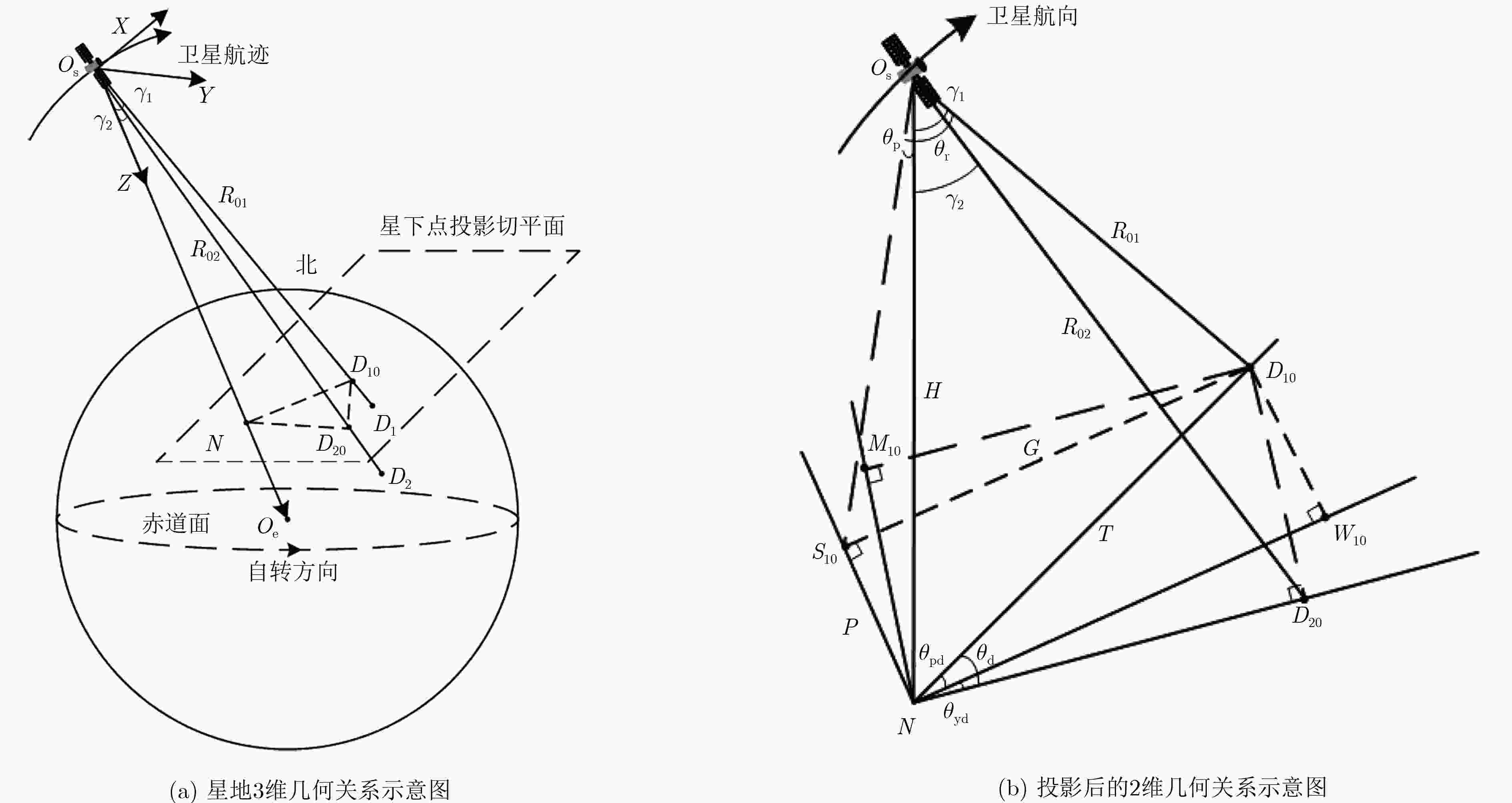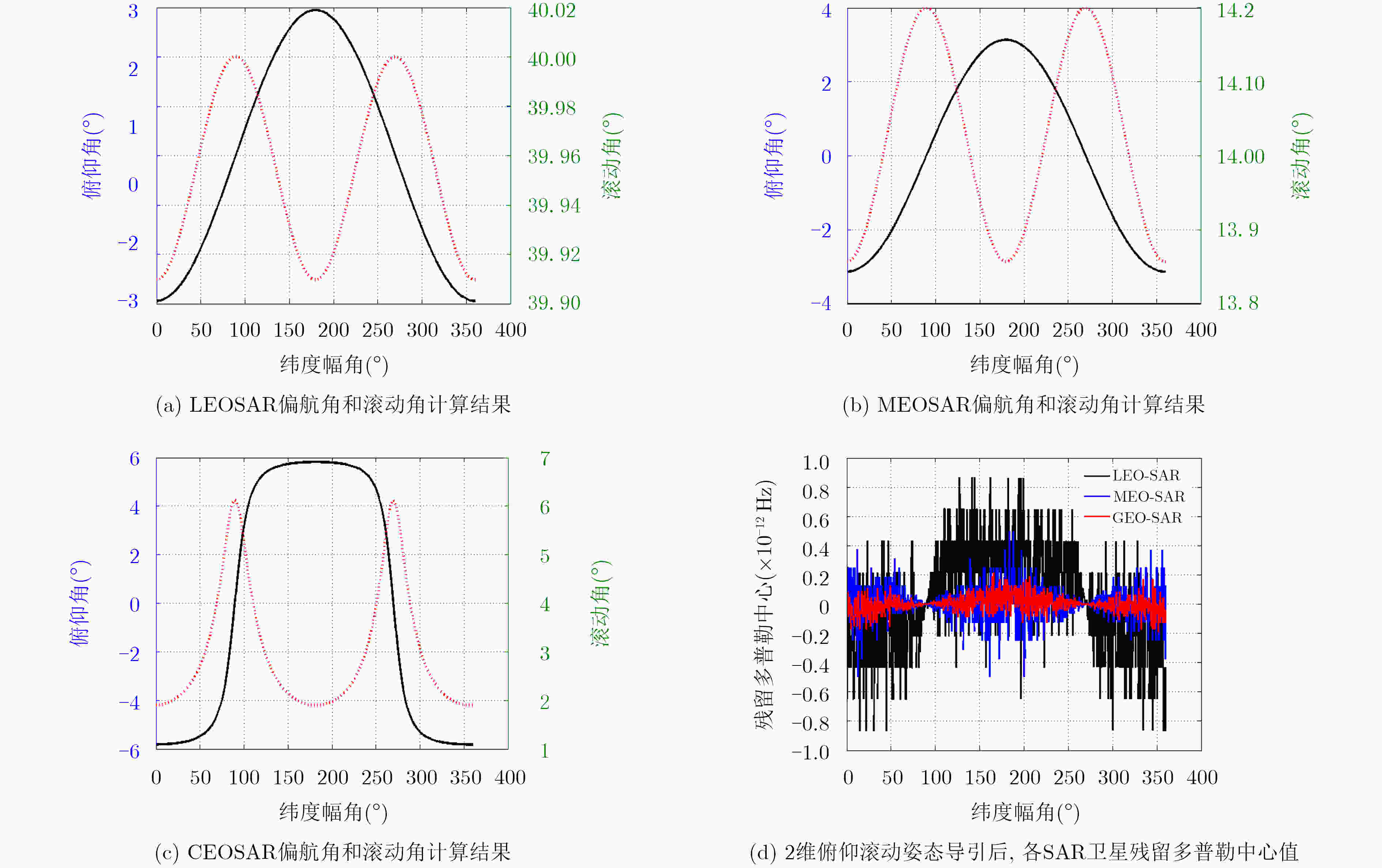A New Prompt 2-D Attitude Steering Approach for Zero Doppler Centroid of GEOsynchronous SAR
-
摘要:
该文针对地球同步轨道合成孔径雷达(GEOSAR)提出一种新的2维俯仰–滚动姿态导引方法,可有效解决传统2维偏航导引方法用于GEOSAR时大偏航角的问题,更适用于具有大功率、大天线和大转动惯量的GEOSAR卫星。该方法应用于GEOSAR卫星时,不需调整偏航角,仅通过调整不超过±8°的俯仰角和滚动角,即可实现正侧视。相较于传统导引方法,该方法将卫星机动角度和时间减小至1/10左右,可大幅降低GEOSAR工程实施难度。该方法应用于不同轨道高度的SAR卫星时,均可实现残留多普勒中心值为0,具有普适性。此外,针对不同轨道高度SAR卫星,该文提出了姿态导引方法选择的参考依据。
-
关键词:
- 地球同步轨道合成孔径雷达 /
- 残留多普勒中心 /
- 2维俯仰–滚动姿态导引
Abstract:A new prompt 2-D attitude steering approach for zero Doppler centroid of GEOsynchronous SAR (GEOSAR) is proposed. Large yaw angle of GEOSAR in traditional 2-D yaw steering condition can be solved by this method. It is suited to the large satellite such as GEOSAR. The GEOSAR can achieve broadside imaging when this method is applied. Compared to the traditional attitude steering approach, the steering angle and time are just 1/10 of it, and the developing difficulty of GEOSAR becomes lower through this new method. This approach is propitious to GEOSAR. When it is employed to SAR satellites with different altitudes, the residual Doppler centroid is accurate zero in all the conditions. Besides, an attitude selection reference standard is illustrated for different altitude orbital satellites.
-
表 1 各轨高SAR卫星仿真参数
参数名称 LEOSAR MEOSAR GEOSAR 轨道高度 (km) 514 12000 35792 轨道倾角(°) 97.42 40 30 轨道偏心率 0.003 0.003 0.003 入射角(°) 45 45 45 近地点幅角(°) 90 90 90 升交点赤经(°) 0 0 0 地球模型 WSG84 WSG84 WSG84 系统波长(m) 0.031 0.031 0.031 表 2 GEOSAR从待机状态启动至正侧视成像状态的耗时对比
姿控角速率(°/s) 2维偏航导引(min) 2维俯仰-滚动导引(min) 0.01 125 12.7 0.02 62.5 6.3 0.03 42.7 4.2 -
张薇, 杨思全, 范一大, 等. 高轨SAR卫星在综合减灾中的应用潜力和工作模式需求[J]. 航天器工程, 2017, 26(1): 127–131 doi: 10.3969/j.issn.1673–8748.2017.01.018ZHANG Wei, YANG Siquan, FAN Yida, et al. Application potential and working mode requirements of GEO SAR satellite for comprehensive disaster reduction[J]. Spacecraft Engineering, 2017, 26(1): 127–131 doi: 10.3969/j.issn.1673–8748.2017.01.018 WEI Guo, JIE Chen, WEI Liu, et al. Time-variant TEC estimation with fully polarimetric GEO-SAR data[J]. Electronics Letters, 2017, 53(24): 1606–1608 doi: 10.1049/el.2017.3297 梁建, 张润宁. GEO-LEO双站视频SAR系统若干问题研究[J]. 现代雷达, 2017, 39(3): 17–20 doi: 10.16592/j.cnki.1004-7859.2017.03.004LIANG JIan, and ZHANG Run Ning. A Study on key technologies of spaceborne video SAR system based on GEO-LEO bistatic model[J]. Modern Radar, 2017, 39(3): 17–20 doi: 10.16592/j.cnki.1004-7859.2017.03.004 Li Dexin, MARC R C, PAU P I, et al. Reverse back projection algorithm for the accurate generation of SAR raw data of natural scenes[J]. IEEE Geoscience and Remote Sensing Letters, 2017, 14(11): 2072–2076 doi: 10.1109/LGRS.2017.2751460 CHEN Jianlai, SUN Guangcai, MENG Daoxing, et al. A parameter optimization model for geosynchronous SAR sensor in aspects of signal bandwidth and integration time[J]. IEEE Geoscience and Remote Sensing Letters, 2016, 13(9): 1374–1378 doi: 10.1109/LGRS.2016.2587318 ZHENG Lifang, ZHANG Shunsheng, and ZHANG Xiangqian. A novel strategy of 3D imaging on GEO SAR based on multi-baseline syetem[C]. IGARSS, Texas, USA, 2017: 1724–1727. TOMIYASU K. Synthetic aperture radar in geosynchronous orbit[C]. IEEE Antennas and Propagation Symposium, Maryland, USA, 1978(2): 42–45. HU Cheng, LI Yuanhao, DONG Xichao, et al. Accurate three dimensional deformation retrieval in geosynchronous SAR by multi-aperture interferometry processing[C]. Progress In Electromagnetic Research Symposium, Shanghai, China, 2016: 5125–5130. 王跃锟, 李真芳, 张金强, 等. GEO-LEO双站SAR地面分辨特性及轨道构型分析[J]. 系统工程与电子技术, 2017, 39(5): 996–1001 doi: 10.3969/j.issn.1001-506X.2017.05.07WANG Yuekun, LI Zhenfang ZHANG Jinqiang, et al. Ground resolution characteristic and orbital configuration analysis for GEO-LEO BiSAR[J]. Systems Engineering and Electronics, 2017, 39(5): 996–1001 doi: 10.3969/j.issn.1001-506X.2017.05.07 JORDAN R and RODGERS D. The SEASAT-A synthetic aperture radar system[J]. IEEE Jounal of Oceanic Engineering, 1980, 5(2): 154–164 doi: 10.2514/6.1976-966 TOMIYASU K and PACELL J L. Synthetic aperture radar imaging from an inclined geosynchronous orbit[J]. IEEE Transaction on Geoscience and Remote Sensing, 1983, 21(3): 324–328 doi: 10.1109/TGRS.1983.350561 RANEY R K. Doppler properties of radars in circular orbits[J]. International Journal of Remote Sensing, 1986, 7(9): 1153–1162 doi: 10.1080/01431168608948916 FIERDLER H, BOENER E, MITTERMAYER J, et al. Total zero doppler steering: a new method for minimizing the doppler centroid[J]. IEEE Geoscience and Remote Sensing Letters, 2005, 2(2): 141–145 doi: 10.1109/LGRS.2005.844591 YU Ze, ZHOU Yin, CHEN Jie, et al. A new satellite attitude steering approach for zero Doppler centroid[C]. IET International Radar Conference, Guilin China, 2009: 1–4. ZHANG Jiabiao, Yu ZE, and PENG Xiao. A novel antenna beam steering strategy for GEO SAR staring observation[C]. IGARSS, Beijing, China, 2016: 1106–1109. TENG Long, XI Chaodong, CHENG Hu, et al. A new method of zero-doppler centroid control in GeoSAR[J]. IEEE Geoscience and Remote Sensing Letters, 2011, 8(3): 512–516 doi: 10.1109/LGRS.2010.2089969 陈溅来, 杨军, 孙光才, 等. 高轨SAR多普勒中心补偿的二维姿态控制方法[J]. 电子与信息学报, 2014, 36(8): 1972–1977 doi: 10.3724/SP.J.1146.2013.01573CHEN Jianlai, YANG Jun, SUN Guangcai, et al. A two-dimensional attitude steering method to compensate doppler centroid in GEO SAR[J]. Journal of Electronics &Information Technology, 2014, 36(8): 1972–1977 doi: 10.3724/SP.J.1146.2013.01573 -






 下载:
下载:







 下载:
下载:
